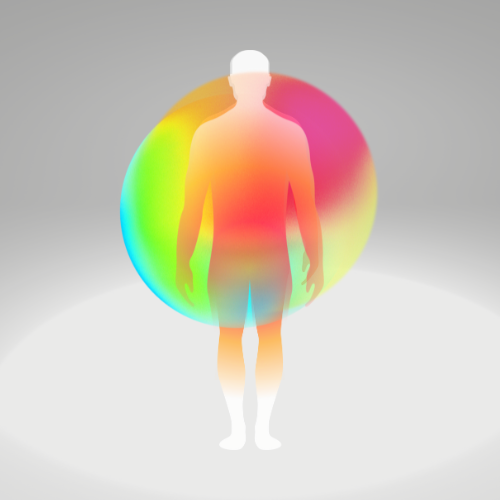The way in which a person forms intimate bonds with themselves is called embodiment.
The word “Soma” comes from a Greek origin which translates to “The Living Body”, it’s the cosmic biological intelligence of our life force to self-organise, self regulate through the relational being of our body-mind the moment we are conceived.
Somatics is an embodiment practice and to become embodied means we are attuned to our soma.
Embodiment is experienced by transitioning from your thoughts to your physical sensations. It is felt during activities like walking, dancing, running, surfing, and swimming etc.
Sensations like skin tingling in a cool breeze, inhaling pine scents in a dense forest, and feeling grass underfoot can also be embodiment. Being fully present in the moment is essential to experiencing embodiment.

Most of us grow up thinking the body is a flesh and blood organism made up of parts and systems. It is something that is described and researched, an object to be known. Rarely do we think of the body as something that knows things.
The “I” or ego, is the mind—specifically the intellect.
Academic fields are coming around in theory and practice to the perspective that the body has a powerful role to play in understanding cognition, in understanding consciousness, and cannot ultimately be separated from it.
The body and mind are on a course to bodymind. Yet at the same time that the fields of science and the humanities (and some contemplative teachers) continue a turn towards embodiment and an extended model of cognition, the way we live as humans has become less embodied.
Disembodiment
What is disembodiment? The answer to that question depends on whom you ask, and which field of study you consult. In the field of psychology, disembodiment is currently understood as a state of dis-integration of body and mind.
In simpler language, within psychology, disembodiment seems to be a generic word for experiences of losing track of somatic feeling, the body’s movements, or the relationship of one’s own body to other bodies.
When we pay attention to our body, we are immediately confronted with the truth that we are animals, that we are part of a delicate balance, and that we are mortal.
Reclaiming Embodiment It is a state in which the mind listens to the body. Ultimately, it is a state of being in which the division between mind and body dissolves.
Embodiment is not an idea. It is not a theory. It is a state of being.
You feel embodiment when you drop down from your thinking mind into the feeling body.
Embodiment – Listening to the Body
The recent research on interoception (internal sensory system in which the physical and emotional states of the person are consciously or unconsciously noticed, recognised and responded to) has begun to correlate improved interoceptive awareness with mindfulness. I think of mindfulness ultimately as somatic attention, as a widening of awareness to the felt sense field. This widening of awareness is not a thinking process. It is an act of listening to the body. Listening to the body involves dropping our attention—even pouring our attention—down from the push and pull of the thinking mind into the field of feeling and perception that is happening right now. This is a profound redirection of attention, away from rumination and towards a relaxed but focused awareness. That awareness is “listening” in the sense that it is receptive to the body’s trans-linguistic communication.
When you listen to your body in this way, you discover gems of wisdom held by your somatic field (body, sensations, emotions).
How to support yourself when you are experiencing a trigger or stressful event, and are needing skills for relief.
Increase your somatic, mind- body awareness.
Somatic approaches are used to connect the relationship between mind, body, brain, and behaviour and create a healing process.
When you’re healing from anxiety, trauma or are experiencing emotional triggers, it can be difficult to feel like your body is supporting you.
Ways to work with triggers is to ground yourself, and practice orienting yourself to your body so you can support yourself when triggered.
How to orient to your body:
- What does your posture feel like? are you slumped, rigid, or have a flexibility to your stance?
- What’s your natural heart rate? Quick, slow?
- Where do you carry tension? does it present as a knot in your stomach, neck/back pain, a headache, a tingling in your fingers or twitching of your eye?
- What external or internal elements offer a sense of calm? A favorite sweater, drink, place (beach, sofa), or experience with a loved one?
- What external stimuli often trigger you? loud sounds, dark at night, social interactions?
The 6-step somatic embodiment exercise:
1. Notice.
Inhale and exhale. Notice what you feel on, in and around your body. Speed of breath, heart rate and body temperature.
2.Think back to safety.
Think back to at a recent moment you felt most calm, safe and most like your “self”.
3. Identify.
Identify at what point in time and/or which part of your body began experiencing disturbance or stress.
4. Replay.
Replay the scenario from calm state to stressed state, in slow motion (as if watching a slow movie). Identify people, conversations, objects or behaviors that may have made you stressed, uncomfortable or that stand out to you as you’re replaying the recent event(s).
5. Tune in.
Tune in to your body sensations as you recall the event(s) and slow down and notice if there is any shift in your body, a sensation of tingling, tensing, warming, numbing or cooling in your chest, arms, legs, face or an overall change in body temperature.
6. Healing hands.
Place your hand on the area that has experienced a shift or change, and breath deeply. If it’s an overall feeling, you can simply place your hands on your heart.
Doing this allows the body to process the somatic experience, and creates a passageway to release the tension.
Notice if something comes up, an image, sensation, awareness or understanding that offers clarity to the situation. If nothing comes up, that’s ok. Simply slowing down, pacing your breath and raising awareness is progress and helpful in itself.
One of the main schools of somatics was created by Thomas Hannah in the 1970s, who named the concept of “somatics.”
Not long after, Dr. Peter Levine developed somatic experiences partly from observing how animals recover from repeated traumatic experiences.
Throughout the 1970s, 80s, and 90s, different kinds of somatic therapy interventions emerged. What all of them have in common is the belief that the body is connected to the mind and can help heal a person facing challenges with their mental health, which proved to be a more holistic approach than traditional talk therapy.
The body-oriented therapeutic approach Somatic Experiencing® (SE) treats post-traumatic symptoms by changing the interoceptive and proprioceptive sensations associated with the traumatic experience, was developed by Peter Levine, Ph.D., as the result of a multidisciplinary study of stress physiology, psychology, ethology, biology, neuroscience, indigenous healing practices, and medical biophysics.
The aim of SE is to guide clients to develop increasing tolerance for difficult bodily sensations and suppressed emotions.
The primary goal of SE is to modify the trauma-related stress response. To achieve this, its major interventional strategy builds on bottom-up processing. Clients’ attention is directed to internal sensations, both visceral interoception (internal sensory system in which the physical and emotional states of the person are consciously or unconsciously noticed, recognised and responded to) and musculoskeletal such as proprioception (your body’s ability to sense movement, action, and location) and kinaesthesis (the ability to feel movements of the limbs and body, rather than to primarily cognitive or emotional experiences.



